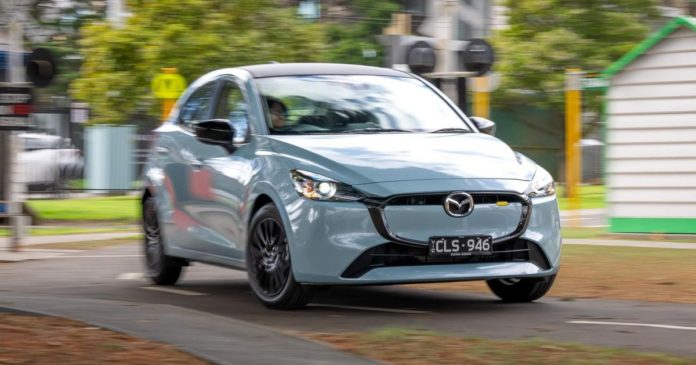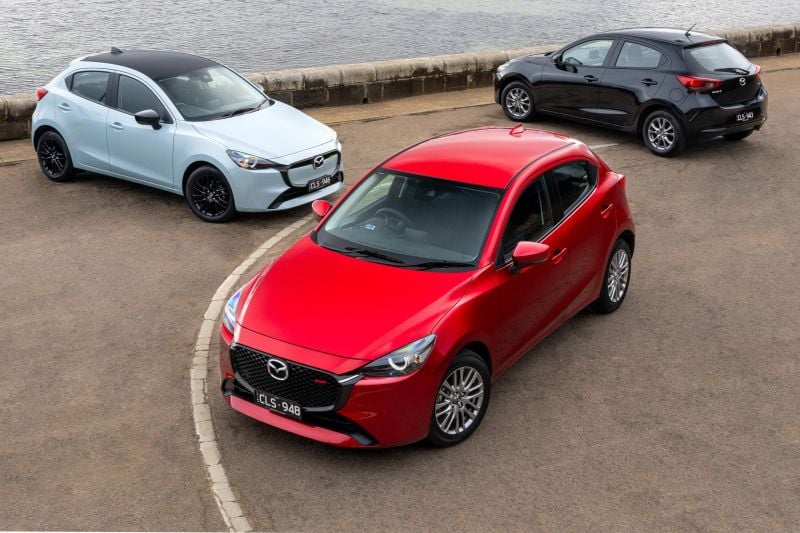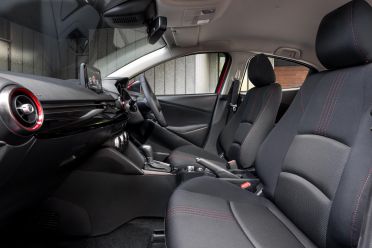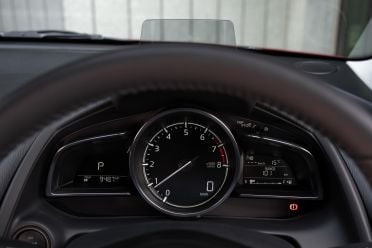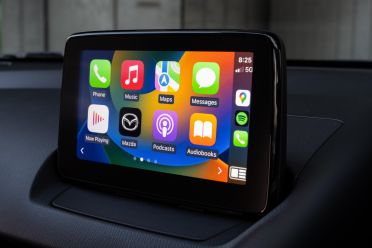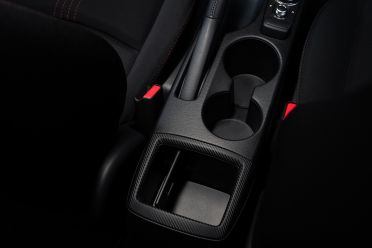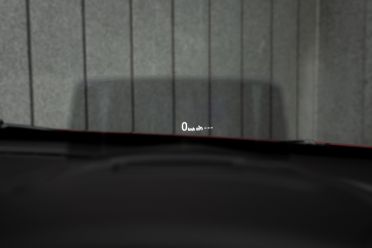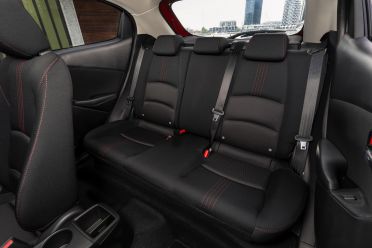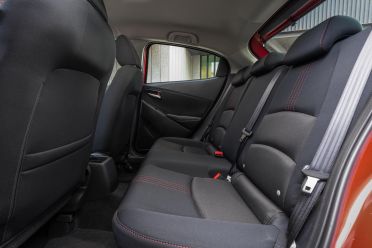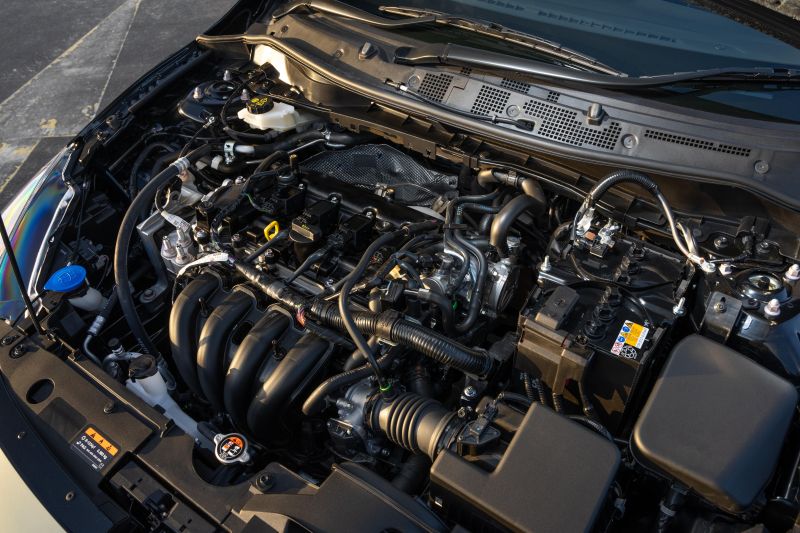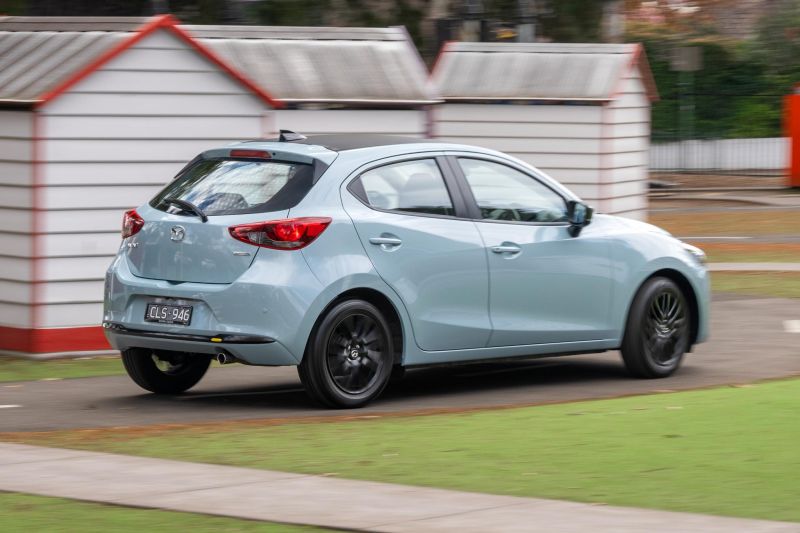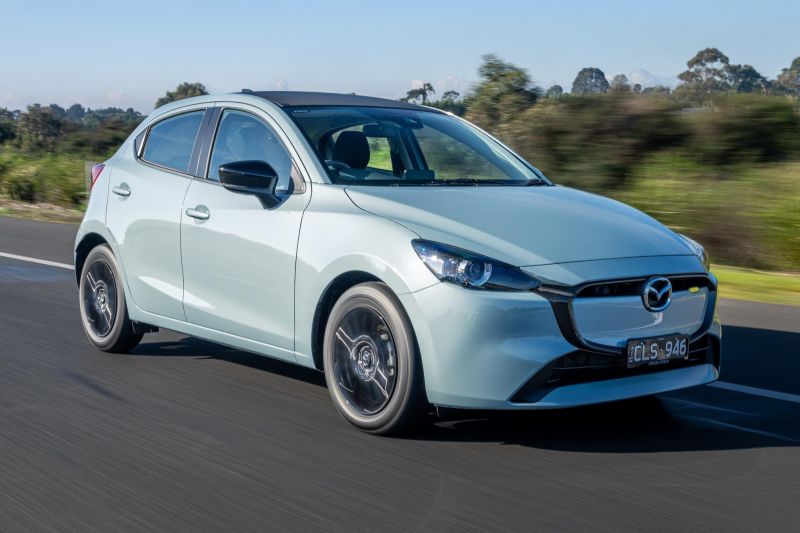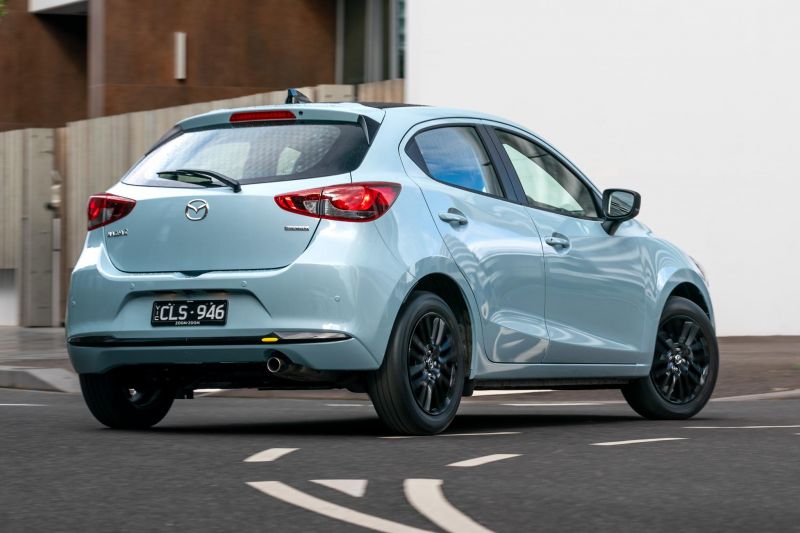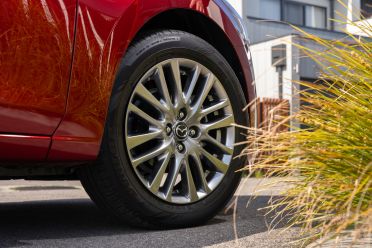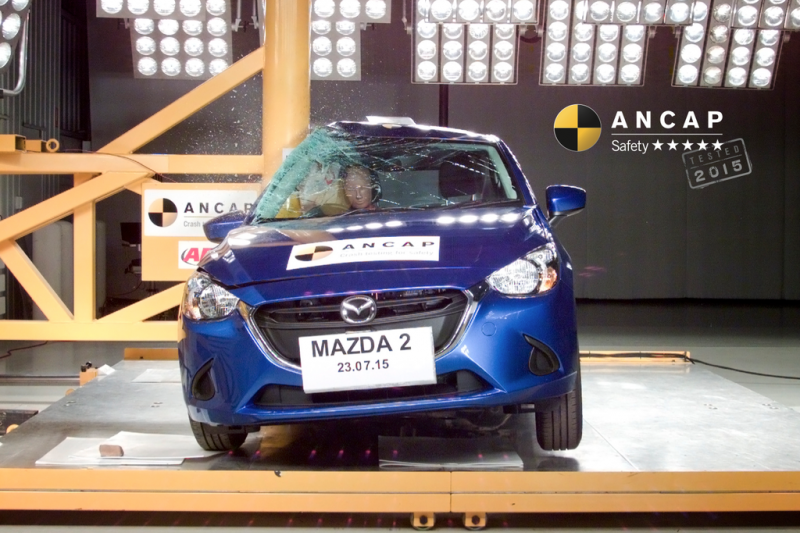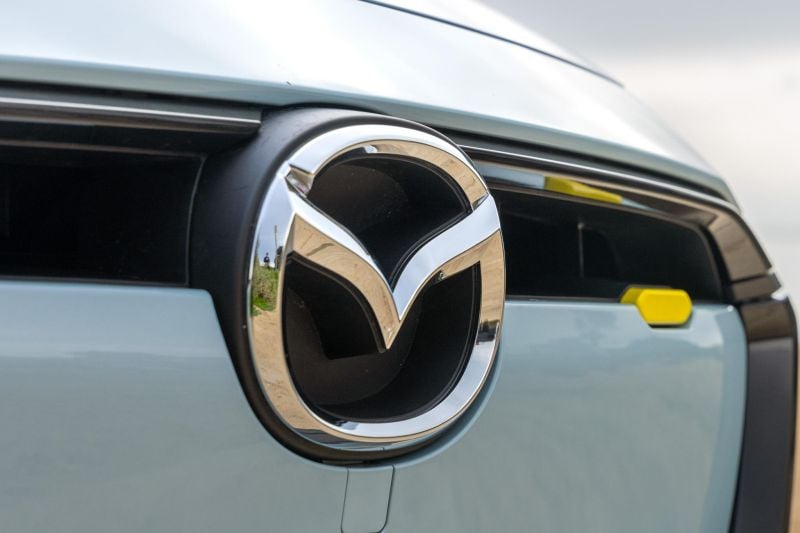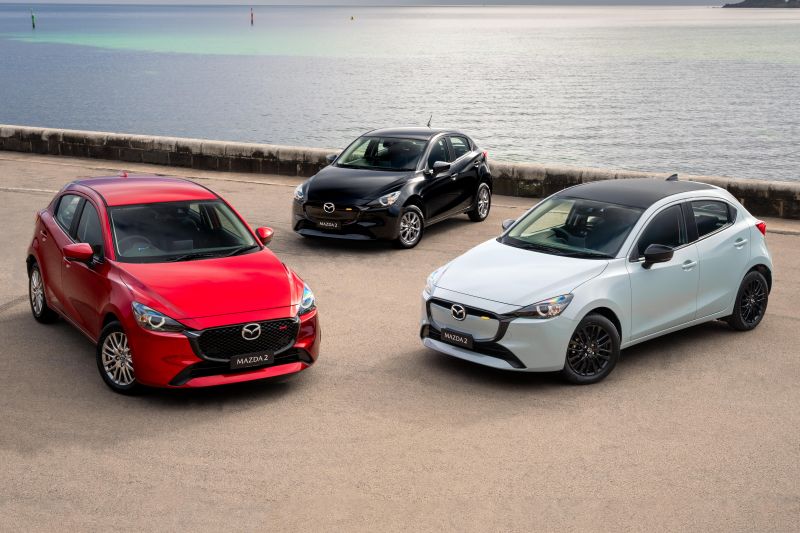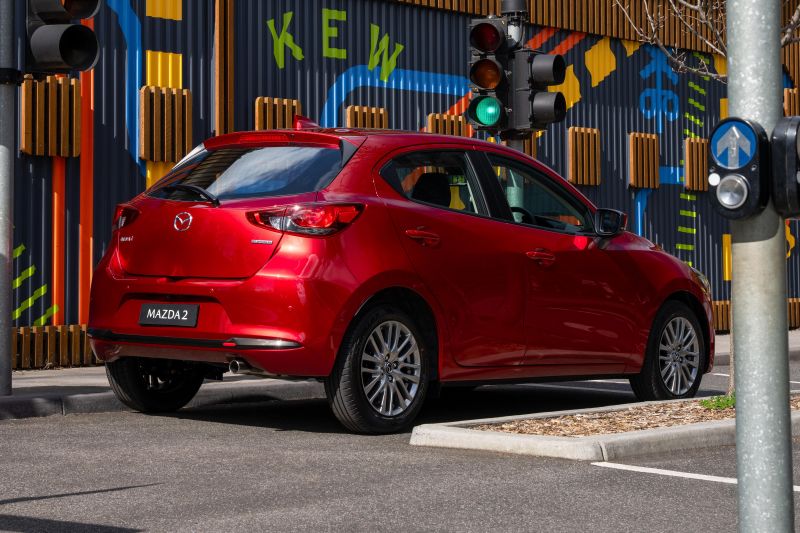It’s almost been 10 years since the current Mazda 2 debuted in Australia. This year the fun-sized hatch is back with new colours, and more efficiency for models fitted with the automatic transmission – but carries a slightly increased price tag.
-
G15 Evolve
Mazda is even holding strong on offering a manual in its smallest car. The manual is only available in the base trim level, while an automatic transmission is offered throughout the range.
This year Mazda has introduced two new exterior paint colours, in Aero Grey and Airstream Blue. It’s refreshed the front bumper and now offers a body-coloured grille on Pure and Pure SP variants, while the Evolve and flagship GT receive a black-mesh styled front bumper.
Pricing starts from $22,410 before on-road costs for the Pure manual and stretches to $27,610 before-on roads for the range-topping GT auto. That’s pricier than before, although it’s still much cheaper than a Toyota Yaris.
-

G15 Pure
The Mazda 2 competes in the ever-shrinking light car segment. As of June 2023 it’s outsold the Toyota Yaris, Volkswagen Polo, and Suzuki Baleno.
The Kia Rio (2950) has marginally overtaken the Mazda 2, while the MG 3 remains the class leader on sales.
How much does the Mazda 2 cost?
The Mazda 2 is the most affordable car in Mazda’s line-up. The range opens at $22,410 before on-road costs for the Pure hatch manual.
The Mazda 2 Pure automatic is available in either hatch or sedan, with either body style priced from $24,410 before on-road costs.
If a sportier Pure SP hatch is more to your liking this starts from $25,210 before on-road costs. Continuing with the hatches, the Evolve is priced at $25,610 before on-road costs.
The flagship Mazda 2 GT is priced at $27,610 before on-road costs for both the sedan and hatch.
Within its segment the Mazda 2 range threads the needle between the bargain MG 3 and pricey Volkswagen Polo and Toyota Yaris.
The most affordable light car to rival the Mazda 2 is the MG 3 Core auto which starts from $19,990 drive-away. The Kia Rio also offers more affordable pricing, kicking off at $19,690 before on-roads.
The Mazda does undercut the Volkswagen Polo though, which kicks off at $25,990 before on-roads, along with the Toyota Yaris range ($24,800 before on-roads and up).
Mazda 2 pricing:
- 2023 Mazda 2 Pure hatch manual: $22,410
- 2023 Mazda 2 Pure hatch auto: $24,410
- 2023 Mazda 2 Pure sedan auto: $24,410
- 2023 Mazda 2 Pure SP hatch auto: $25,210
- 2023 Mazda 2 Evolve hatch auto: $25,910
- 2023 Mazda 2 GT hatch auto: $27,610
- 2023 Mazda 2 GT sedan auto: $27,610
All prices are excluding on-road costs.
What is the Mazda 2 like on the inside?
The Mazda 2 is the brand’s entry-level vehicle, and it feels pared back alongside the more luxurious Mazda 3. With that said, Mazda has worked to update the cabin for 2024.
-
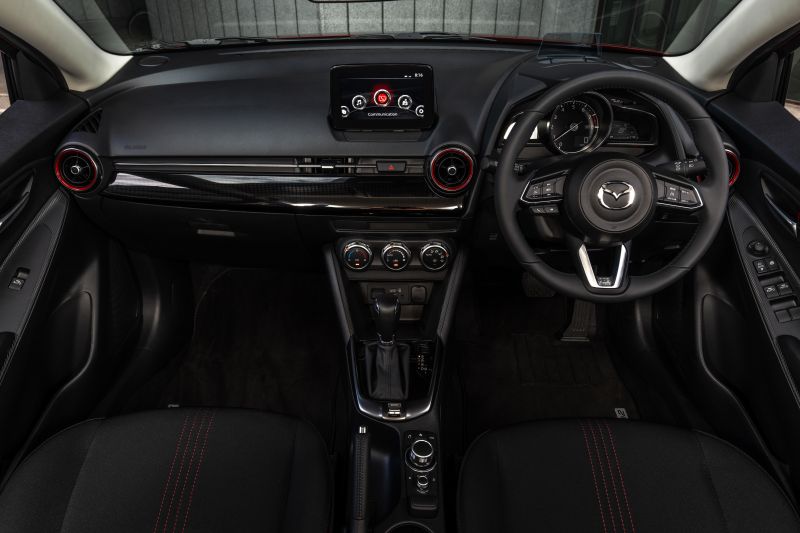
G15 Evolve shown
All trim levels have manual seating adjustment, so it can take a bit of fiddling to get comfortable, but once you’ve dialled in the right position the 2 is a comfortable place to spend time.
Both fabric and leather seats were equally comfortable, and I wouldn’t prefer one over the other. Leather is easier to clean if you’re the sort of person likely to spill your extra large iced Frappuccino; cloth is nice on hot summer days where leather burns are a real risk in Australia.
The leather-wrapped steering wheel is the same design and shape across the entire Mazda 2 range. It’s easily adjustable with reach and tilt customisation, and feels nice when driving.
The buttons are at a comfortable position and allow you to use the cruise control and change your audio, answer or decline phone calls, or use voice commands.
This is a car aimed at young buyers, so tech functionality is especially important.
The infotainment system features a touchscreen capabilities (when at a complete stop) which is a welcome inclusion. On the move though, you’ll need to use the rotary dial down near the gear selector.
The Apple CarPlay works fine, but if you’re toggling between apps and need to quickly get back to the navigation it takes a little while longer to do so because you’re forced to use the dial in the centre console.
The infotainment system software itself is easy to navigate and use, but compared to some of its competitors can be a bit bland visually. Newer Mazda models have a fresher looking infotainment system.
Considering the car is targeted at young buyers seeking their first car, the fact my iPhone wouldn’t fit in the small cavity beneath the USB ports is an oversight. The phone slides from side-to-side, which gets annoying quickly.
Alternatively, I’m not too sure what the small storage space could be used for considering it’s the only place you can store a phone if it’s plugged into the USB port.
I was surprised the centre console had room for two 600ml drink bottle. With the lack of armrests, if you store 600ml Frank Green bottles you can almost form a makeshift armrest for the driver.
For long drives or a day trip to the beach not having a place to rest your arm was slightly annoying, although it’s not uncommon in this class.
The inside of the Pure features chrome accents throughout the dashboard and centre console, which is a nice touch.
When you jump up to the Evolve and GT, the interior does feel more welcoming and plush. It has chrome accented air-conditioning dials that are much nicer to touch and look at.
The carbon-like inserts on the centre console and colour-coded stitched on the seats to match the dashboard and elevate the feel within the premium Evolve and GT models. In the Evolve and GT drivers receive a colour heads-up display.
The back seat is small, but that’s to be expected from a compact car of this size.
It does feature two ISOFIX points and three top tether points for child seats, but I would be surprised if you could fit tall-ish people in front of a rear-facing seat.
Tall adults will have trouble feeling comfortable in the back seat, but they’re usable in a pinch.
The hatch offers 250L of boot space which is just enough for a medium sized luggage and not much else. For day-to-day activities such as school bags and grocery bags this boot size is compact but will do the job.
The sedan offers almost double the amount of boot space (440L), so if you are frequently carrying baggage or cargo this sedan might be better suited.
What’s under the bonnet?
The Mazda 2 uses a naturally aspirated 1.5-litre four-cylinder petrol engine producing 81kW of power and 142Nm (82kW/144Nm in the manual), and is front-wheel drive.
It’s mated with either a six-speed manual or six-speed automatic transmission.
Automatic Mazda 2 models use 5.0L/100km on the ADR combined cycle (5.4L/100km with the manual), feature a 44L fuel tank, and run on 91 RON regular unleaded fuel.
How does the Mazda 2 drive?
I had time to drive both the automatic and the manual but in very seperate settings.
-
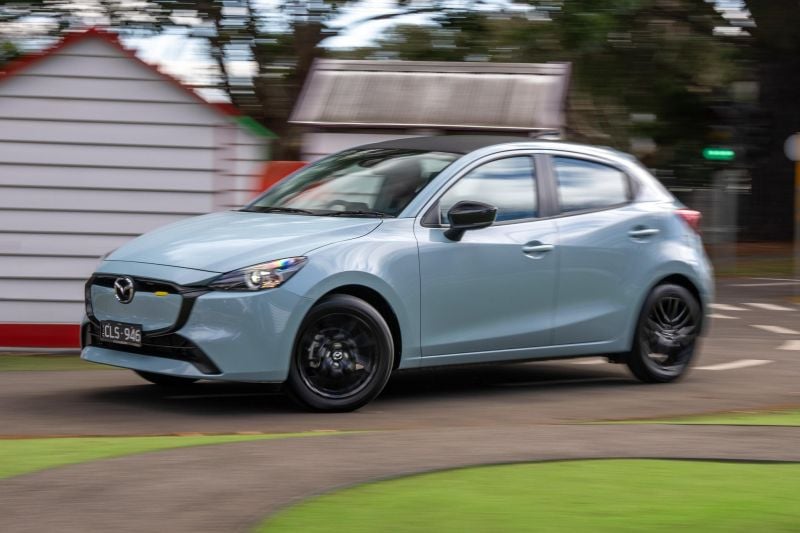
G15 Pure SP
The automatic is not going to be the fastest car away from the lights, but it does pack enough of a punch to keep up with traffic. It feels most at home in tight streets, with light steering that makes it easy to park.
Despite its tiny footprint, the GT in particular feels stable at highway speeds and around corners. It was a pleasant surprise knowing if you need to, you can take this car on the highway for long trips without being uncomfortable.
For the most part the engine smooth and quiet, but it gets a bit noisy if you’re in a real hurry. The six-speed automatic is perfectly simple, with no awkwardness.
Quirks? The right-hand mirror is very magnified, which can make it hard to know where the side of the car is relative to traffic.
If you’re a new driver, adjusting to the different magnification levels of the left and right-hand mirrors takes some doing.
The manual is a great first-timers manual. It’s almost impossible to stall at low speeds, and is very forgiving when the clutch is in.
I drove it mostly around a test track on various surfaces including gravel, dirt and mud, and sealed roads, and it handled it all nicely.
Speaking of stalling… if perhaps like me you’re new to a manual transmission Mazda’s auto start/stop is great.
If the car does stall, nine times out of 10 to restart the engine all you need to do is put the clutch in and the car will start up again which is great for getting off the mark quickly.
There were quite a few potholes on the driving route, and they were easy to notice inside the car. The car really slapped into some of them hard, which wasn’t all that comfortable in the cabin.
The safety systems were responsive and do the job well. Cruise control was smooth and I didn’t even notice when the lane-keeping system was activated because it was very seamless and non-intrusive.
What do you get?
The G15 Pure sedan and hatch come standard with the following equipment:
- 15-inch alloy wheels
- Power-folding exterior mirrors
- LED headlights
- Automatic headlights (NEW)
- Rain-sensing wipers
- 7.0-inch infotainment screen
- Wireless Apple CarPlay (NEW)
- Wired Android Auto
- DAB+ digital radio
- Leather-wrapped steering wheel
- Leather-wrapped shifter and handbrake
- Tilt and telescopic steering wheel adjustment
- Six-speaker sound system
- Keyless start
- Air-conditioning
- Power windows
- 1 x 12V outlet
- 2 x USB outlet
The G15 Pure SP hatch adds:
- 16-inch black-finish alloy wheels
- Carbon fibre-style roof (NEW)
- Shark fin antenna (NEW)
- Chrome exhaust extension (NEW)
- Black exterior mirrors
Over the G15 Pure, the G15 Evolve hatch adds:
- 16-inch alloy wheels
- Black mesh-style grille (NEW)
- LED daytime running lights
- Climate control air-conditioning
- Auto-dimming rear-view mirror (NEW)
- Colour head-up display
- Satellite navigation
- Red stitching details (NEW)
- Traffic sign recognition
The G15 GT hatch and sedan add:
- Keyless entry
- Black leather/Grand Luxe suede upholstery with red highlights (NEW)
- Front parking sensors
- Surround-view camera
- Adaptive cruise control
Is the Mazda 2 safe?
The Mazda 2 had a five-star rating from ANCAP, but as this was based on testing conducted in 2015 it has now expired.
Mazda Australia says it currently has no plans to retest the Mazda 2 as the model has largely remained the same since then.
All models come standard with the following equipment:
- Autonomous emergency braking (forward and reverse)
- Blind-spot monitoring
- Lane-keep assist
- Rear cross-traffic alert
- Rear parking sensors
- Reversing camera
- Front, side and curtain airbags
G15 Evolve and above get traffic sign recognition, while the G15 GT gains a surround-view camera, front parking sensors, and adaptive cruise control.
How much does the Mazda 2 cost to run?
The 2024 Mazda 2 is covered by five-year, unlimited-kilometre warranty.
Both manual and automatic models require servicing every 12 months or 15,000 kilometres, whichever comes first.
Mazda offers capped-price servicing for the first seven-years or 105,000 kilometres.
| Manual | Automatic | |
|---|---|---|
| 12 months or 15,000km | $334 | $334 |
| 24 months or 30,000km | $526 | $526 |
| 36 months or 45,000km | $396 | $396 |
| 48 months or 60,000km | $526 | $526 |
| 60 months or 75,000km | $473 | $334 |
| 72 months or 90,000km | $587 | $587 |
| 84 months or 105,000km | $334 | $334 |
| Total: | $3176 | $3037 |
CarExpert’s Take on the Mazda 2
It’s tough to compete in a market where players keep leaving, and the remaining options are getting more expensive.
I am very happy a manual is still available. It provides a great entry level option for those looking to learn – like me – or those looking for an “affordable” manual as a run around.
The interior could do with an update, though. This is the second update in 10 years, but there’s only so much you can do with a refresh – it’s what ages the Mazda 2 most.
There’s still a place for it, though. Sitting between the cheaper MG 3 and newer, pricier Toyota Yaris, it offers a balance of luxury and economy.
Mazda says most of its long-term customers start in a Mazda 2, before moving up the chain. It’s a cute, quirky and safe car to drive. It handles well, and if it was my first car, I wouldn’t complain.
Click an image for the full gallery.
MORE: Everything Mazda 2

